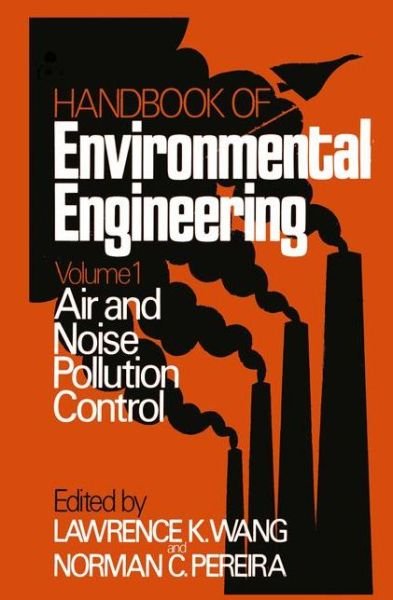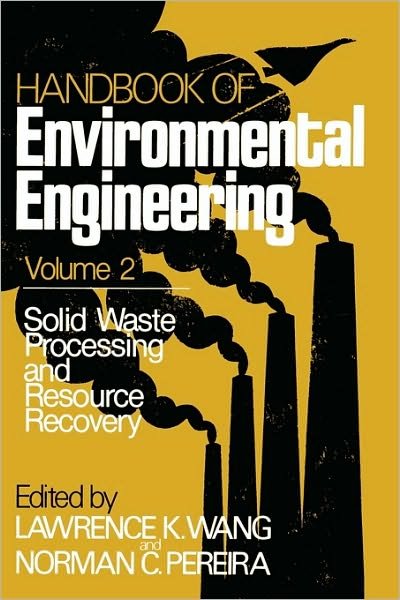
Tell your friends about this item:
Air and Noise Pollution Control: Volume 1 - Handbook of Environmental Engineering 1979 edition
Lawrence K Wang
Air and Noise Pollution Control: Volume 1 - Handbook of Environmental Engineering 1979 edition
Lawrence K Wang
Since pollution is a direct or" indirect consequence of waste, if there is no waste, there can be no pollution, and the seemingly idealistic demand for" zero discharge" can be construed as a demand for zero waste.
Marc Notes: Includes bibliographical references and indexes.;v. 1. Air and noise pollution control --v. 2. Solid waste processing and resource recovery --v. 3. Biological treatment processes -- v. 4. Water resources and natural control processes. Table of Contents: I Air Pollution Control.- 1 Introduction to Air Pollution.- I. Introduction.- II. Characteristics of Air Pollutants.- III. Standards.- A. Ambient Air Quality Standards.- B. Emission Standards.- IV. Sources.- V. Effects.- VI. Measurement.- A. Ambient Sampling.- B. Source Sampling.- C. Sample Locations.- D. Gas Flow Rates.- E. Relative Humidity.- F. Sample Trains.- G. Size Distribution Determination.- VII. Control.- VIII. Conclusions.- References.- 2 Fabric Filtration.- I. Introduction.- II. Principle and Theory.- III. Application.- A. General.- B. Gas Cleaning.- C. Efficiency.- D. Some Operational Variables.- IV. Economics.- V. Example Problem.- Nomenclature.- References.- 3 Cyclones.- I. Introduction.- II. Performance Characteristics.- A. Types.- B. Standard Designs.- C. Areas of Application.- III. Performance Modeling.- A. Flow Pattern.- B. Pressure Drop.- C. Efficiency.- D. Other Performance Variables.- E. Overall Efficiency on Polydisperse Dust.- IV. Cyclone Design.- A. Necessary Design Information.- B. Cyclone Specification.- C. Design Example.- D. Other Design Considerations.- Nomenclature.- References.- 4 Electrostatic Precipitation.- I. Introduction.- II. Principles of Operation.- A. Corona Discharge.- B. Electrical Field Characteristics.- C. Particle Charging.- D. Particle Collection.- III. Design Methodology and Considerations.- A. Precipitator Size.- B. Electrode Systems.- C. Power Requirements.- D. Gas Flow Systems.- E. Precipitator Housing.- F. Removal of Collected Particles.- G. Instrumentation.- IV. Applications.- V. Problems and Corrections.- A. Fundamental Problems.- B. Mechanical Problems.- C. Operational Problems.- D. Chemical Problems.- VI. Costs.- A. Installation.- B. Operation and Maintenance.- C. Total Cost or Unit Cost.- VII. Expected Future Developments.- Nomenclature.- References.- 5 Wet Scrubbing.- I. Introduction.- II. Fundamental Concepts.- A. Mass Transfer.- B. Particle Collection.- III. Linking Fundamentals to Design Approaches.- A. Transfer Unit Method.- B. Energy Dissipation (or Power) Density.- C. Contacting Power Concept for Particle Removal.- D. Unit Mechanisms.- IV. Scrubber Types, Their Selection and Efficiency.- A. Types.- B. Selection.- C. Efficiency.- V. Design Parameters.- A. Plate Scrubbers.- B. Packed Towers: Fixed-Bed Packing.- C. Packed Towers: Mobile-Bed Packing.- D. Packed Towers: Fibrous Packing.- E. Preformed Sprays.- F. Gas-Atomized Sprays.- G. Centrifugal Devices.- H. Baffle Scrubbers.- VI. Auxiliary and Ancillary Equipment; Disposal of Wastes.- A. Gas Moving.- B. Liquid Moving.- C. Liquid Recycle.- D. Liquid Disposal.- E. Sampling and Analysis.- F. Corrosion Control.- VII. Costs.- VIII. Industrial Applications.- A. Removal of Hydrochloric Acid Gas.- B. Absorption of Nitrogen Oxides.- C. Particle Removal.- D. Simultaneous Gas and Particle Removal.- IX. Design Example.- Nomenclature.- References.- 6 Atmospheric Dilution.- I. Introduction.- II. The First 85 km of Earth s Atmosphere.- III. Turbulence.- IV. Turbulent Transport Phenomena.- A. Equations of Transport: Laminar.- B. Equations of Transport: Turbulent.- C. Reynold s Analogy.- V. Turbulent Diffusion Models.- A. Statistical Diffusion Models.- B. K Theory.- C. Lagrangian Similarity Theory.- VI. Numerical Modeling.- VII. Wind Tunnel Modeling.- VIII. Industrial Air Pollution.- A. Meteorological Factors in Choosing a Site for Major Stationary Sources.- B. Atmospheric Stability.- C. Plume Rise.- D. Concentration Computation.- Nomenclature.- References.- 7 Ventilation And Air Conditioning.- I. Air Ventilation and Circulation.- A. General Discussion.- B. Typical Applications.- II. Ventilation Requirements.- A. Rate of Air Change.- B. Rate of Minimum Air Velocity.- C. Volumetric Air Flow Rate per Unit Floor Area.- D. Heat Removal.- III. Ventilation Fans.- A. Type.- B. Fan Laws.- C. Fan Selection to Meet a Specific Sound Limit.- IV. Hood and Duct Design.- A. Theoretical Considerations.- B. Hoods for Cold Processes.- C. Hoods for Hot Processes.- D. Ducts.- V. Air Conditioning.- A. General Discussion and Considerations.- B. Typical Applications.- VI. Design Examples.- Nomenclature.- References.- 8 Other Air Pollution Control Techniques.- I. Introduction.- II. Process Modification.- III. Vehicle Air Pollution and its Control.- A. Background.- B. Standards.- C. Sources of Loss.- D. Control Techniques and Alternate Power Plants.- IV. Mechanical Particulate Collectors.- A. General.- B. Gravitational Collectors.- C. Other Methods.- D. Use of Chemicals.- E. Simultaneous Particle-Gas Removal Interactions.- V. Entrainment Separation.- VI. Adsorption.- A. Introduction.- B. Physical Adsorption.- C. Chemical Adsorption.- D. Design.- E. Application.- VII. Conclusions.- Nomenclature.- References.- II Noise Pollution Control.- 9 Introduction to Noise Pollution.- I. Introduction.- II. Characteristics of Noise.- III. Standards.- IV. Sources.- V. Effects.- VI. Measurement.- VII. Control.- References.- 10 Noise Control.- I. Introduction.- II. The Physics of Sound.- A. Sound.- B. Speed of Sound.- C. Sound Pressure.- D. Frequency.- E. Wavelength.- F. RMS Sound Pressure.- G. Sound Level Meter.- H. Sound Pressure Level.- I. Loudness.- J. Sound Power Level.- K. Sound Energy Density.- III. Indoor Sound.- A. Introduction.- B. Sound Buildup and Sound Decay.- C. Diffuse Sound Field.- D. Normal Modes.- E. Reverberation Time.- F. Optimum Reverberation Time.- G. Energy Density and Reverberation Time.- H. Relationship between Direct and Reflected Sound.- IV. Sound Out of Doors.- A. Sound Propagation.- B. Wind and Temperature Gradients.- C. Barriers.- V. Noise Reduction.- A. Absorptive Materials.- B. Nonacoustical Parameters of Absorptive Materials.- C. Absorption Coefficients.- VI. Sound Isolation.- A. Introduction.- B. Transmission Loss.- C. Noise Reduction.- VII. Vibrations.- A. Introduction.- B. Vibration Isolation.- VIII. Design Examples.- Nomenclature.- References."Publisher Marketing: The past few years have seen the emergence of a growing, widespread desire in this country, and indeed everywhere, that positive actions be taken to restore the quality of our environment, and to protect it from the degrading effects of all forms of pollution-air, noise, solid waste, and water. Since pollution is a direct or" indirect consequence of waste, if there is no waste, there can be no pollution, and the seemingly idealistic demand for" zero discharge" can be construed as a demand for zero waste. However, as long as there is waste, we can only attempt to abate the consequent pollution by converting it to a less noxious form. In those instances in which a particular type of pollution has been recognized, three major questions usually arise: 1, How serious is the pollution? 2, Is the technology to abate it available? and 3, Do the costs of abatement justify the degree of abatement achieved? The principal intention of this series of books is to help the reader to formulate answers to the last two of the above three questions. The traditional approach of applying tried-and-true solutions to specific pollution problems has been a major factor contributing to the success of environmental engineering, and in large measure has accounted for the establishing of a "methodology of pollution control.
| Media | Books Hardcover Book (Book with hard spine and cover) |
| Released | May 31, 1979 |
| ISBN13 | 9780896030015 |
| Publishers | Humana Press Inc. |
| Pages | 484 |
| Dimensions | 164 × 239 × 33 mm · 1.13 kg |
| Editor | Pereira, Norman C. |
| Editor | Wang, Lawrence K. |
More by Lawrence K Wang
See all of Lawrence K Wang ( e.g. Hardcover Book and Paperback Book )

 Christmas presents can be returned until 31 January
Christmas presents can be returned until 31 January


![Cover for Lawrence K Wang · Modern Water Resources Engineering - Handbook of Environmental Engineering (Hardcover Book) [2014 edition] (2014)](https://imusic.b-cdn.net/images/item/original/941/9781627035941.jpg?lawrence-k-wang-2014-modern-water-resources-engineering-handbook-of-environmental-engineering-hardcover-book&class=scaled&v=1452342615)


![Cover for Lawrence K Wang · Water Resources and Control Processes: Volume 4 - Handbook of Environmental Engineering (Paperback Book) [Softcover reprint of the original 1st ed. 1986 edition] (2011)](https://imusic.b-cdn.net/images/item/original/770/9781461291770.jpg?lawrence-k-wang-2011-water-resources-and-control-processes-volume-4-handbook-of-environmental-engineering-paperback-book&class=scaled&v=1452342615)
![Cover for Lawrence K Wang · Biological Treatment Processes: Volume 3 - Handbook of Environmental Engineering (Paperback Book) [Softcover reprint of the original 1st ed. 1986 edition] (2011)](https://imusic.b-cdn.net/images/item/original/763/9781461291763.jpg?lawrence-k-wang-2011-biological-treatment-processes-volume-3-handbook-of-environmental-engineering-paperback-book&class=scaled&v=1452342615)
![Cover for Lawrence K Wang · Air Pollution Control Engineering - Handbook of Environmental Engineering (Paperback Book) [Softcover reprint of hardcover 1st ed. 2004 edition] (2010)](https://imusic.b-cdn.net/images/item/original/978/9781617373978.jpg?lawrence-k-wang-2010-air-pollution-control-engineering-handbook-of-environmental-engineering-paperback-book&class=scaled&v=1611797325)
![Cover for Lawrence K Wang · Advanced Physicochemical Treatment Technologies: Volume 5 - Handbook of Environmental Engineering (Paperback Book) [Softcover reprint of hardcover 1st ed. 2007 edition] (2010)](https://imusic.b-cdn.net/images/item/original/096/9781617378096.jpg?lawrence-k-wang-2010-advanced-physicochemical-treatment-technologies-volume-5-handbook-of-environmental-engineering-paperback-book&class=scaled&v=1608672484)
![Cover for Lawrence K Wang · Biosolids Engineering and Management - Handbook of Environmental Engineering (Paperback Book) [Softcover reprint of hardcover 1st ed. 2008 edition] (2010)](https://imusic.b-cdn.net/images/item/original/102/9781617378102.jpg?lawrence-k-wang-2010-biosolids-engineering-and-management-handbook-of-environmental-engineering-paperback-book&class=scaled&v=1447406341)
![Cover for Lawrence K Wang · Advanced Air and Noise Pollution Control: Volume 2 - Handbook of Environmental Engineering (Paperback Book) [Softcover reprint of hardcover 1st ed. 2005 edition] (2010)](https://imusic.b-cdn.net/images/item/original/170/9781617375170.jpg?lawrence-k-wang-2010-advanced-air-and-noise-pollution-control-volume-2-handbook-of-environmental-engineering-paperback-book&class=scaled&v=1451270562)
![Cover for Lawrence K Wang · Advanced Physicochemical Treatment Processes - Handbook of Environmental Engineering (Paperback Book) [Softcover reprint of hardcover 1st ed. 2006 edition] (2010)](https://imusic.b-cdn.net/images/item/original/194/9781617375194.jpg?lawrence-k-wang-2010-advanced-physicochemical-treatment-processes-handbook-of-environmental-engineering-paperback-book&class=scaled&v=1604003129)

![Cover for Lawrence K Wang · Environmental Biotechnology - Handbook of Environmental Engineering (Hardcover Book) [2010 edition] (2010)](https://imusic.b-cdn.net/images/item/original/660/9781588291660.jpg?lawrence-k-wang-2010-environmental-biotechnology-handbook-of-environmental-engineering-hardcover-book&class=scaled&v=1511356310)

![Cover for Lawrence K Wang · Biosolids Engineering and Management - Handbook of Environmental Engineering (Hardcover Book) [2008 edition] (2008)](https://imusic.b-cdn.net/images/item/original/614/9781588298614.jpg?lawrence-k-wang-2008-biosolids-engineering-and-management-handbook-of-environmental-engineering-hardcover-book&class=scaled&v=1425177836)
![Cover for Lawrence K Wang · Biosolids Treatment Processes: Volume 6 - Handbook of Environmental Engineering (Hardcover Book) [2007 edition] (2007)](https://imusic.b-cdn.net/images/item/original/961/9781588293961.jpg?lawrence-k-wang-2007-biosolids-treatment-processes-volume-6-handbook-of-environmental-engineering-hardcover-book&class=scaled&v=1614341095)

![Cover for Lawrence K Wang · Advanced Physicochemical Treatment Processes - Handbook of Environmental Engineering (Hardcover Book) [2006 edition] (2006)](https://imusic.b-cdn.net/images/item/original/619/9781588293619.jpg?lawrence-k-wang-2006-advanced-physicochemical-treatment-processes-handbook-of-environmental-engineering-hardcover-book&class=scaled&v=1626516653)


